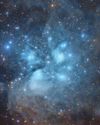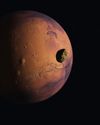Try GOLD - Free
EVERYTHING YOU NEED TO KNOW ABOUT THE MILKY WAY
All About Space UK
|Issue 146
The Milky Way is our home galaxy – a vast star factory with a monstrous black hole at its heart. Join our tour of the cosmic pinwheel that’s home to every star we can see in the night sky

SPIRAL IN SPACE
The shape of the Milky Way in the sky reveals that our Solar System is embedded in a broad but thin plane of stars. Looking away from the band of the Milky Way, we see past the relatively nearby stars that lie in our part of this plane into apparently empty intergalactic space. However, when we look across the plane we see many more stars extending to greater distances; their combined light forms the band of the Milky Way. Radio astronomy observations, which can see past dense clouds of stars and dust to map the distribution of hydrogen gas clouds across the plane, confirm that our galaxy has a spiral structure broadly similar to many other galaxies in the sky – in fact, it’s a type of galaxy known as a barred spiral.
The latest measurements suggest the Milky Way is a flattened disc roughly 100,000 light years in diameter and about 1,000 light years deep – although stray trails of stars extend much further out. Stars, gas and dust in the disc slowly orbit around a central bulge of stars roughly 20,000 light years across in the direction of Sagittarius. The spiral arms are concentrations of particularly bright stars and star-forming nebulae that run across the disc, beginning at either end of an elongated stellar bar that extends from the bulge. In total, the Milky Way is thought to contain between 100 billion and 400 billion stars, with our own Solar System located about 26,000 light years from the centre, roughly midway between the two major spiral arms in a region called the Local Arm or Orion Spur.

1 Norma Arm
This story is from the Issue 146 edition of All About Space UK.
Subscribe to Magzter GOLD to access thousands of curated premium stories, and 10,000+ magazines and newspapers.
Already a subscriber? Sign In
MORE STORIES FROM All About Space UK

All About Space UK
MYSTERIES OF THE UNI WHERE ARE ALL THE SPIRAL GALAXIES?
There are far fewer spiral galaxies than elliptical ones in the Supergalactic Plane, and scientists are keen to discover why
7 mins
Issue 161

All About Space UK
ZOMBIE STARS
+10 OTHER TERRIFYING SPACE OBJECTS
8 mins
Issue 161

All About Space UK
HOW TO BEAT LIGHT POLLUTION
Thought it was impossible to observe the wonders of the night sky from towns and cities? Think again. Follow our tips and tricks on successfully observing through sky glow
2 mins
Issue 161

All About Space UK
15 STUNNING STAR CLUSTERS
These beautiful stellar groupings are spattered across the cosmos
8 mins
Issue 161

All About Space UK
Eileen Collins "It was a difficult mission...we were the first to see Mir"
Having served as both the first female pilot and first female commander of NASA's Space Shuttle, Collins boosted the involvement of women in space exploration to a whole new level
9 mins
Issue 161

All About Space UK
MARS LEAKS FASTER WHEN IT'S CLOSER TO THE SUN
The Red Planet has lost enough water to space to form a global ocean hundreds of kilometres deep
2 mins
Issue 161

All About Space UK
FUTURE TECH KANKOH-MARU
This ambitious reusable spacecraft will be capable of taking 50 people to and from orbit
2 mins
Issue 161

All About Space UK
THE FINAL FRONTIER
Beyond the reach of the Sun is a fascinating region of the cosmos that were only just beginning to explore
8 mins
Issue 161

All About Space UK
A long-lost moon could explain Mars' weird shape and extreme terrain
A long-lost moon could explain why Mars is so different from the other rocky planets in the Solar System. Today Mars has two tiny moons.
2 mins
Issue 161

All About Space UK
A sprinkling of cosmic dust may have helped kick-start life on Earth
Cosmic dust may have helped kick-start life on Earth. New findings challenge a widely held assumption that this wasn't a plausible explanation.
3 mins
Issue 161
Translate
Change font size
